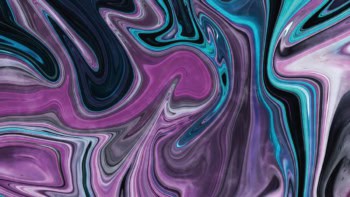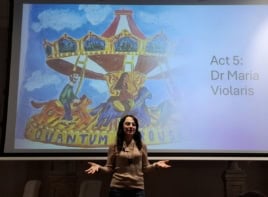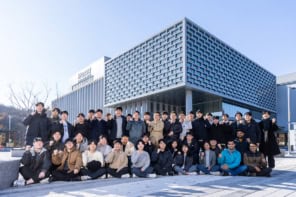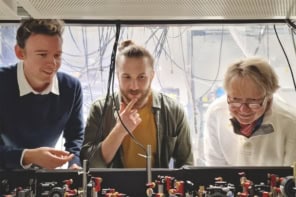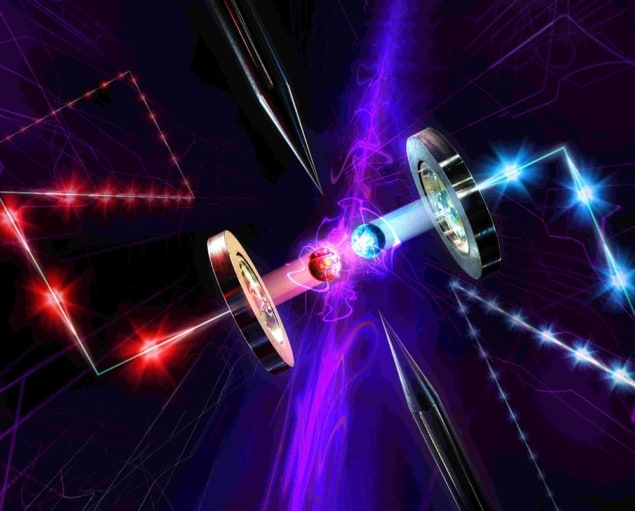
Physicists at the Universities of Innsbruck in Austria and Paris-Saclay in France have combined all the key functionalities of a long-distance quantum network into a single system for the first time. In a proof-of-principle experiment, they used this system to transfer quantum information via a so-called repeater node over a distance of 50 kilometres – far enough to indicate that the building blocks of practical, large-scale quantum networks may soon be within reach.
Quantum networks have two fundamental components: the quantum systems themselves, known as nodes, and one or more reliable connections between them. Such a network could work by connecting the quantum bits (or qubits) of multiple quantum computers to “share the load” of complex quantum calculations. It could also be used for super-secure quantum communications.
But building a quantum network is no easy task. Such networks often work by transmitting single photons that are entangled; that is, its quantum state is closely linked to the state of another quantum particle. Unfortunately, the signal from a single photon is easily lost over long distances. Carriers of quantum information can also lose their quantum nature in a process known as decoherence. Boosting these signals is therefore essential.
Repetition without hesitation or deviation
Quantum repeaters can provide this boost, but not in a straightforward way. Because the rules of quantum mechanics restrict the copying of entangled states, repeaters cannot simply copy the signal they receive and pass it on to the next node. Instead, they must store information in a so-called quantum memory and then transfer it using a process known as a Bell state measurement (BSM).
A fully capable quantum repeater also needs to comply with certain practical requirements. Firstly, the quantum signals need to be at wavelengths used in telecommunications, so they can be transmitted through optical fibres without too much loss. Secondly, the storage time of the quantum memory should exceed the time needed to generate entanglement. Finally, each step in the process should be deterministic, meaning that signals need to be produced after each successful step.
All in one
The latest work, which is described in Physical Review Letters, combines all three practical requirements in a single experiment. In the initial sequence of events, two trapped calcium ions each emit a photon, forming two entangled photon-ion pairs. Here the trapped ions work as qubits, and their quantum states are distributed over the quantum network. The photons in these pairs are then converted to the telecoms wavelength of 1550 nm and sent to two different nodes via separate 25-km-long optical fibres. The total distance between nodes is thus 50 km.
Whenever one of the photons reaches its designated node, the state of its entangled ion gets stored in the ion’s protected memory states. The system then makes repeated attempts to send a second photon (entangled with the second ion) to the other node. Once photons are detected at both nodes, the experimenters perform a BSM to transfer the ion states to their respective entangled photons.
To test this protocol, the researchers repeated it 44 720 times over a period of 33 minutes, registering 2053 successes in 2 229 883 attempts to entangle photons between the remote nodes. That might not sound like a high success rate, but the presence of the ion memories made establishing entanglement 128 times more likely. This indicates that further improvements may be possible, up to the limit where both detectors successfully detect both photons and are restricted only by decoherence in the ions’ memory states.
Extending the network further
The researchers also modelled how far their method could be pushed. Taking into account all the different factors, they showed that a network of 17 ion-based repeater nodes could establish entanglement between ions 800 kilometres apart. According to lead researcher Ben Lanyon of the University of Innsbruck, members of the team now plan to uncoil the fibres that are currently in their labs and send entanglement off campus, into the existing commercial optical fibre network. “Our vision is to get out of the lab and start building quantum networks of matter and light between cities and countries,” he tells Physics World.

New quantum repeaters could enable a scalable quantum internet
Ronald Hanson, a physicist at QuTech in the Netherlands who was not involved in the work, describes the result as important because it combines several elements required for a quantum repeater. In particular, he notes that the experiment demonstrates multi-qubit operation inside the node, efficient qubit-photon interfaces and telecom compatibility, with each element working at high fidelity to give a good overall performance – the most relevant metric. While a fully functioning quantum Internet is still some way off, Hanson believes this demonstration is a step towards functional quantum repeaters based on trapped ions.
